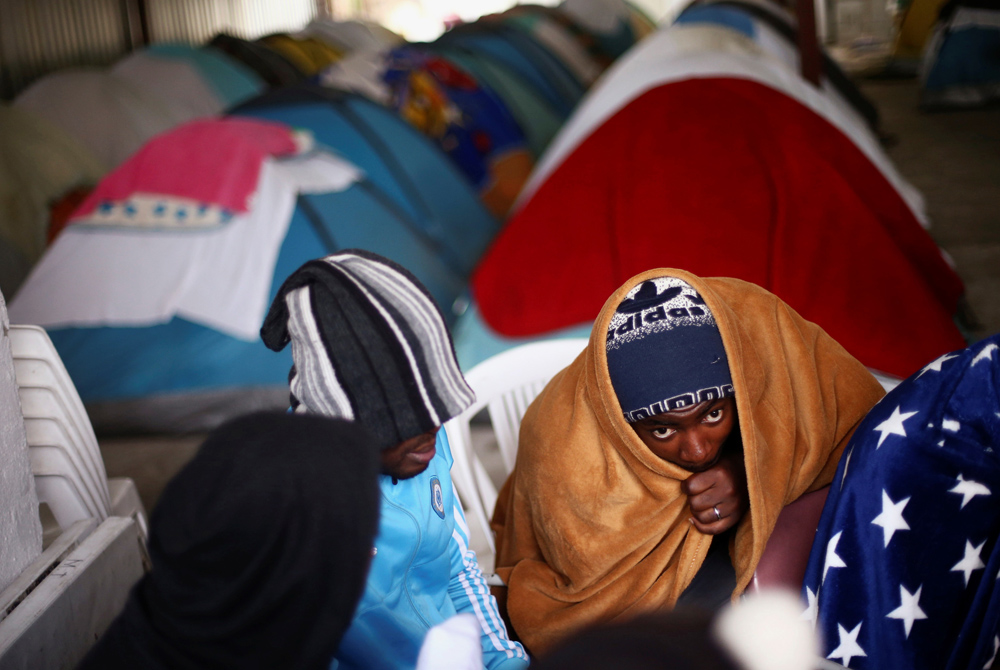
A migrant from Cameroon protects himself from the cold inside a temporary shelter on March 14, 2018, in Tijuana, Mexico. (CNS/Reuters/Edgard Garrido)
While most migrants apprehended at the U.S. border are from Central American countries, a growing number of Africans are making their way to the United States, via the same routes traditionally used by Central Americans and Mexicans. Fleeing ethnic cleansing and political volatility in their respective countries, the migrants are escaping Central African nations like Cameroon, the Democratic Republic of Congo and Angola.
The surge in numbers of this new population surprised border patrol agents who are more accustomed to Spanish-speaking migrants. In June, border patrol apprehended a record number of African refugees and immigrants from 19 countries. According to the Department of Homeland Security, a majority of apprehensions happened along the Del Rio sector in Texas, consisting mostly of family units and single adults.
"The introduction of this new population places additional burdens on processing stations, to include language and cultural differences," Del Rio Sector Chief Patrol Agent Raul Ortiz, said in a statement. "Our agents continue to meet each new challenge as the ongoing humanitarian crisis evolves."
The presence of the extracontinental population — people from a non-Western Hemispheric region transiting through Latin America — at the border is not new, say experts. Historically, there has been a trickle of migrants from other hemispheres traveling through Mexico to reach the U.S. southern border.
"But we have seen that number more than triple, when you compare last year to this year," said Jessica Bolter, associate policy analyst at Migration Policy Institute, a Washington-based non-partisan think tank that conducts research and analysis on the movement of people across the globe.
Based on figures released by Mexican authorities, 2,700 Africans were apprehended in the last fiscal year. The migrants were apprehended near the U.S.-Mexico border and at various checkpoints across the country. The first eight months of this fiscal year (October 2018 to May 2019), Mexican authorities have already apprehended 3,500 individuals.
"The total will at least double," said Bolter.
There are various reasons linked to the increase of African migrants seeking asylum in the United States. According to the UNHCR, the United Nations refugee agency, political upheaval in the Democratic Republic of Congo earlier this year displaced approximately 4.5 million people.
In Cameroon, conflict has been simmering for decades between the French-speaking majority and the Anglophone south. It has finally boiled over, resulting in the deaths of thousands and reports of torture and rape, prompting many to flee. Among those seeking asylum from Africa are LGBTQI people fearing persecution and student activists/organizers fleeing government retribution from countries like Congo and Cameroon. Homosexuality is illegal in 32 African countries.
"Another factor for the uptick in African migration through the region is the increased enforcement along European borders," said Maureen Meyer, director for Mexico and migrant rights at Washington Office on Latin America, an advocacy group promoting human rights, democracy and social and economic justice across the Americas.
Europe struck a deal with countries like Turkey to stem the flow of transit migration to the European Union. Faced with enforcement hurdles and the rising cost of the journey, African migrants are opting for the United States.
Another motivational factor for migrants is family members or acquaintances who made the journey to the U.S. successfully, and then sent word back home.
"The majority of the people arrested from the continent of Africa claimed some form of immigration relief due to credible fear of returning to their country. Families chose to make the journey to the United States in order to take advantage of the legal framework that enabled them to be released if traveling as a family group and claiming fear," a spokesperson of the Customs and Border Patrol told NCR.
The journey to the United States takes months. African migrants enter the Western hemisphere through visas into countries like Ecuador and Brazil, which have lax visa requirements. From there, the migrants travel to Colombia to make the trek through Central America to the U.S. border. The journey through Latin America is strenuous, dangerous and expensive. The most treacherous part is the Darien Gap — the world's most remote jungle region accessible only by foot or canoe. The jungle is populated with snakes, poisonous insects and wild animals. Many migrants die of exhaustion or drown in the river.

A map of the migration routes through Latin America (Courtesy of Migration Policy Institute)
Most migrants' journeys are facilitated by smugglers. Africans pay thousands of dollars in smuggling and bribery fees before finally reaching the U.S. border.
Earlier this year, the Mexican government issued exit visas to extracontinental migrants to continue their journey to the United States. Since July, the government has cracked down heavily on the flow of migrants passing through Mexico, after the Trump administration struck a deal with Mexican president Andrés Manuel López Obrador.
On Oct. 12, the Mexican military police stopped a migrant "caravan" — that included African migrants — which was moving toward the U.S. border.
"Mexico did not want to repeat the image of a caravan of migrants being allowed to travel through its country to the U.S. border. So, they quickly cracked down on that, and I suspect they'll continue doing that," said Bolter.
"Where we see the impact on them [African migrants] is more the overall pressure of the Trump administration on Mexico, to reduce as much as possible, the flow of migrants reaching the United States. And so, this measure is one of several that Mexico is adapting to make it harder for anyone to travel north," said Meyer.
Because of these recent events, the initial surge of migrants from continental Africa has declined, according to U.S. Customs and Border Protection.
The Mexican bishops' conference expressed its concern regarding the administration's deal with Mexico.

The migration route through the Darien Gap (Courtesy of Migration Policy Institute)
"Our brother migrants must never be a bargaining chip. No negotiations should be placed above what the church and civil society have defended for years: not criminalizing migrants nor the defenders of human rights," it said in a statement.
African migrants are left with limited options. They could apply for humanitarian visas, which would allow them to stay in Mexico, or apply for asylum.
"But we have to remember that there's a lot of people that have no language, cultural or any tie to Mexico, and where, I think they would not believe that Mexico is the right country for them — whether that's for safety concerns, or just in terms of their own ability to effectively settle," said Meyer.
Currently camped in the southern state of Chiapas in Mexico, many African migrants are in dire need of humanitarian aid. Many are in overcrowded detention centers.
"Children, women with babies and pregnant women are in detention. But it's worse in Mexico because it's hard for human rights defenders to reach the detained population," said Claudia León from Jesuits Refugee Service in Mexico.
"We do have the opportunity to do [go to detention centers]. But the centers are at very high capacity. And there are a lot of people with so many needs. Even asylum claimers are in detention, which shouldn't be like that, but that's the policy," she said.

A victim of ethnic violence rests inside a hospital on June 25 in Bunia, Congo. (CNS/Reuters/Olivia Acland)
Mexico's immigration law requires asylum-seekers to stay in the state where they requested asylum or a humanitarian visa. As a result, many people can't leave Chiapas.
"So, in the end, what it does is put extreme strain on Chiapas, and in Chiapan border cities, which is a poor state in Mexico, and arguably has less ability to effectively support this population," said Meyer.
Those not in detention centers find themselves homeless and extremely vulnerable to violence. They also face a language barrier, as most speak French, English, Portuguese and almost no Spanish.
"Many of them are homeless, living in the streets or outside. The Mexican government is doing nothing to help them. It's an absolute nightmare," said León.
"What we've actually seen is growing backlash from local residents who are uncomfortable having thousands of people in their communities. They feel like their local plaza has been taken over by immigrants who have no other place to stay except there, so [there's] the increasing sense of xenophobia in certain towns that have this high population staying there," said Meyer.
In August, around 3,000 African migrants formed the Assembly of African Migrants in Tapachula, with help from Center of Human Rights Fray Matias de Cordova based in Chiapas. They demanded expediated transit visas, humanitarian assistance and protection from Mexican security forces.
"I think that the unfortunate part of this is there's a lot of people that might likely qualify for asylum in the United States and may never be given that chance," said Meyer.
Advertisement
The situation, say experts, is only set to worsen in the coming months, with immigration becoming a pivotal issue for President Donald Trump's 2020 reelection campaign.
"The administration has put into place a lot of layers of different policies that are essentially trying to block access to the U.S. for people coming to the southern border," said Bolter.
The administration will be eager to implement agreements it signed with Central American countries to send people back.
"That could certainly affect African migrants. They could be one of the populations subject to these agreements. We don't know how they (agreements) would be implemented. They would probably start off with a small number of people just due to the capacity issues," she said.
Experts say that there could be an increase in smuggling activity, owing to the enforcement of borders.
"What we may likely see is increased smuggling networks, that up until now were basically ensuring people [Africans] could get to southern Mexico. Now they're taking people all the way up to the U.S.-Mexico border. It's not clear how smuggling networks will adapt to this," said Meyer.
"But the general message is that the U.S. is closed — this is certainly something the administration is going to want to pursue," said Bolter.
[Sarah Salvadore is an NCR Bertelsen intern. Her email address is ssalvadore@ncronline.org. Follow her on Twitter @sarahsalvadore.]








